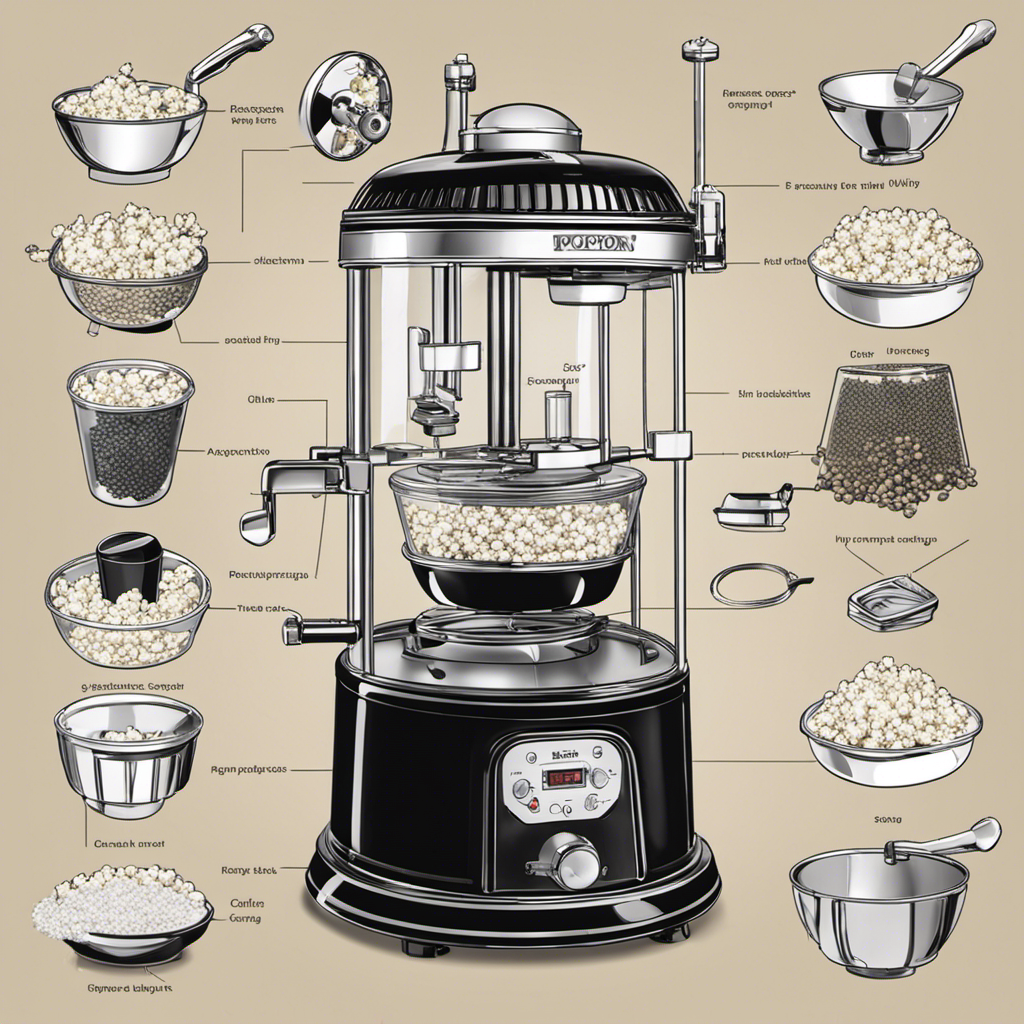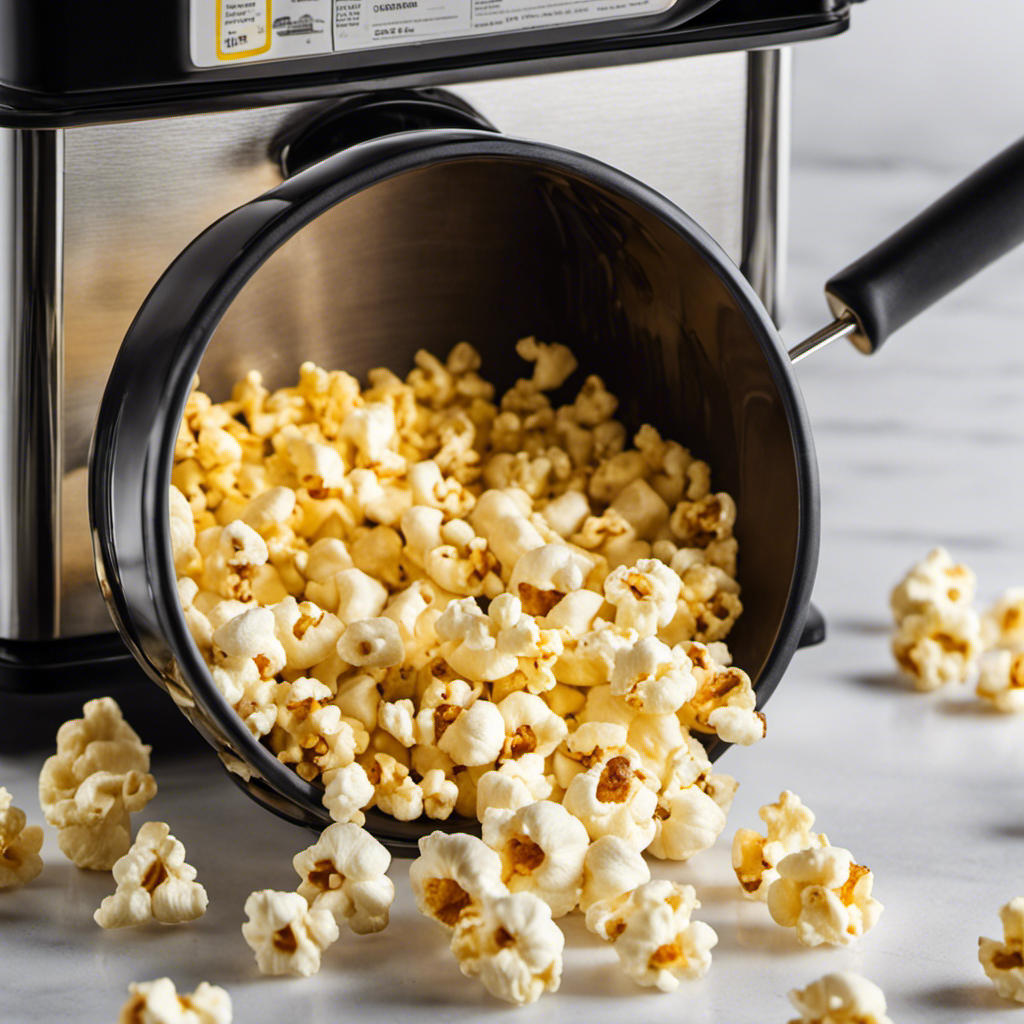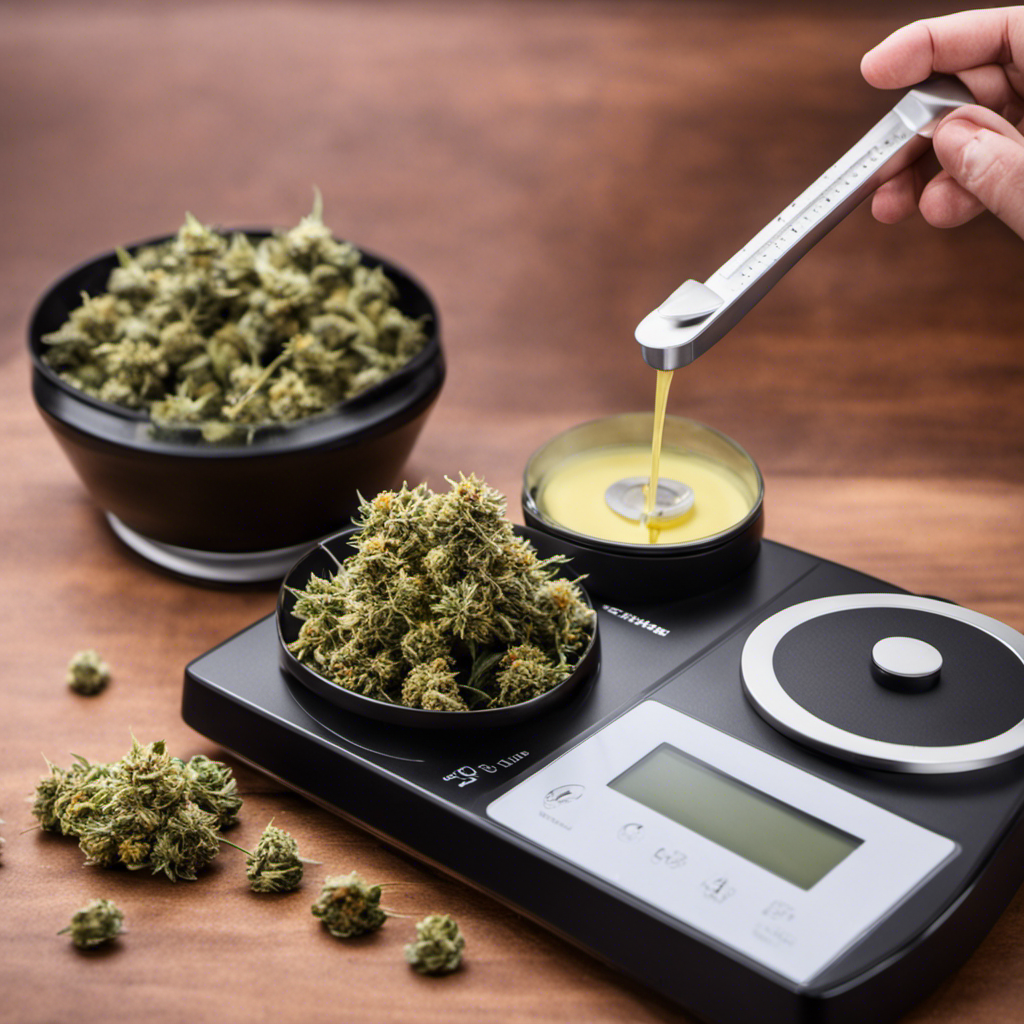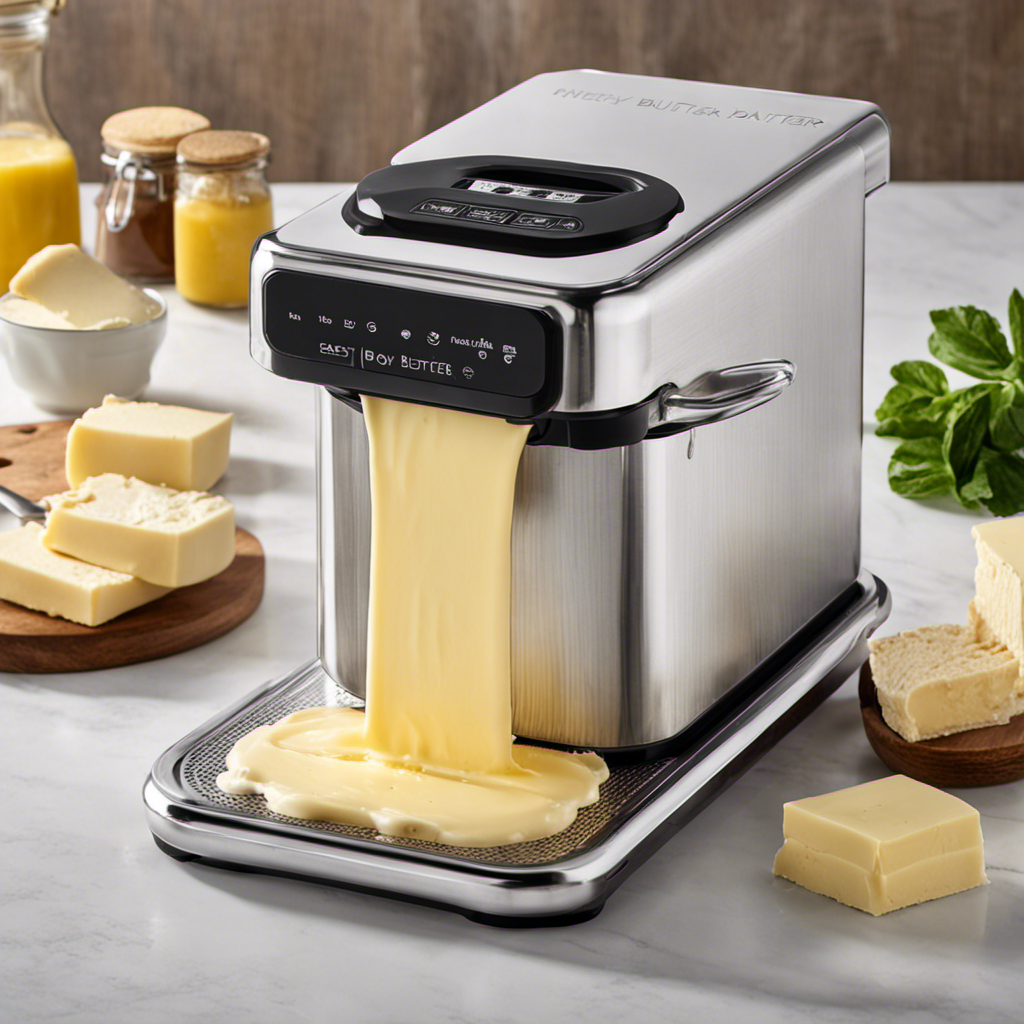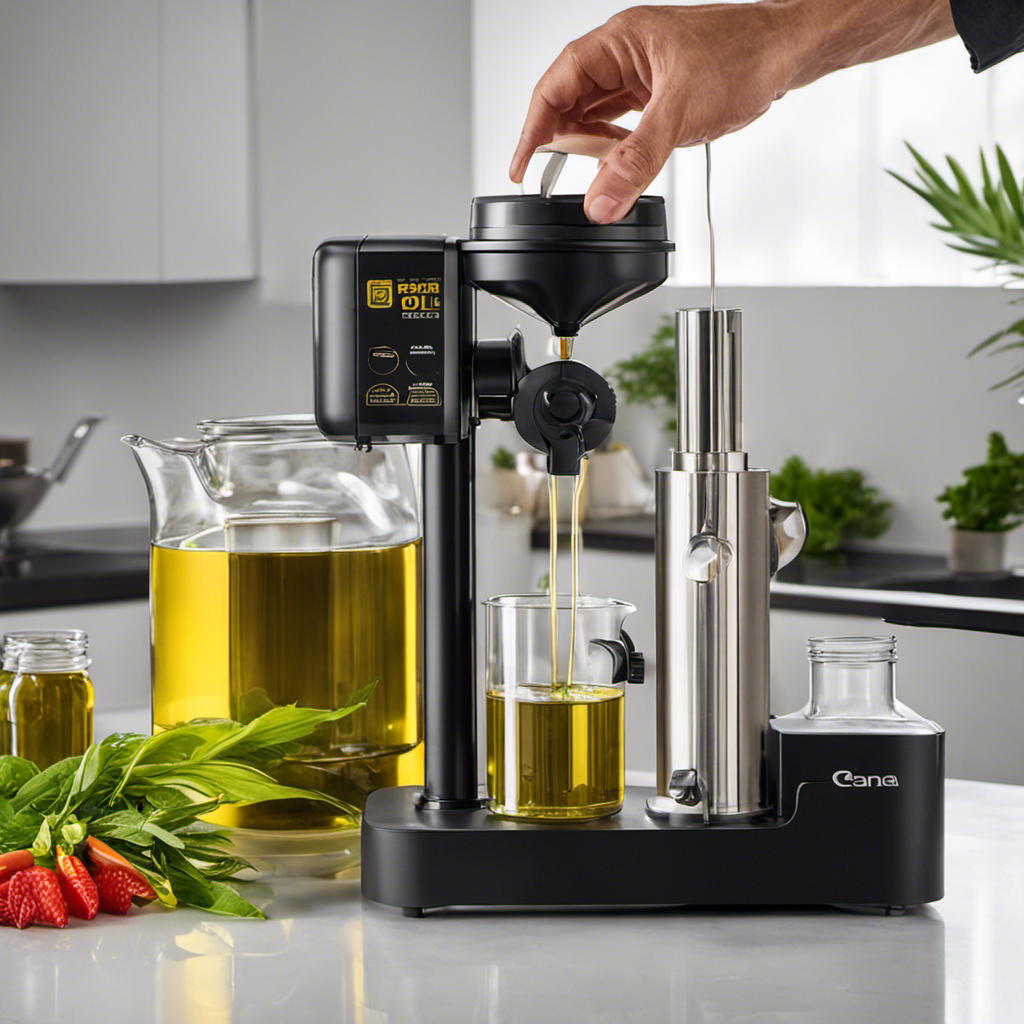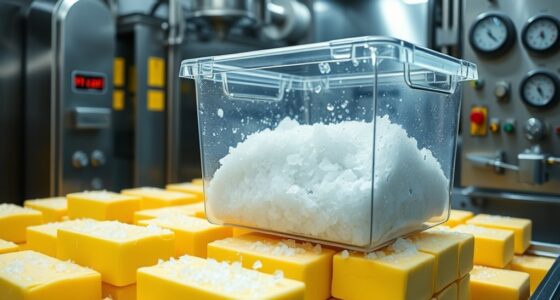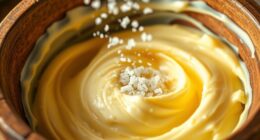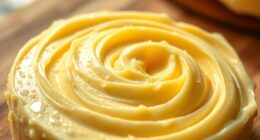I love munching on hot air-popped popcorn, but cleaning up the gooey melted butter residue can be a total hassle. If you want to avoid this sticky situation, keep reading to discover a clever trick that will make cleanup a breeze!
That’s why I’m here to share my tried-and-true method for cleaning out that stubborn butter residue. In this step-by-step guide, I’ll walk you through disassembling the popcorn maker, soaking the parts in warm soapy water, and scrubbing away every last trace of butter.
Say goodbye to greasy popcorn and hello to a squeaky clean popcorn maker!
Key Takeaways
- Use a butter melter and wipe excess butter immediately after each use to prevent build-up.
- Clean the popping chamber and removable parts with warm soapy water after every use.
- Soak stubborn butter residue with equal parts vinegar and water, then wipe clean.
- Avoid using abrasive cleaners or scrubbing pads to prevent damage.
Understanding the Butter Build-up
To understand why the hot air popcorn maker gets clogged with butter, it’s important to know how the butter build-up occurs. When making popcorn, the hot air blows the popcorn kernels up, and at the same time, it melts the butter on top. The melted butter then drips down into the machine, where it can accumulate over time and cause clogs.
To prevent butter build-up, it’s advisable to use a butter melter that can evenly distribute the butter over the popcorn. However, if you already have stubborn butter residue in your hot air popcorn maker, there are ways to remove it.
One method is to let the machine cool down completely, then use a soft cloth or sponge soaked in warm soapy water to wipe away the butter residue. Another option is to use a vinegar and water solution to dissolve the butter.
Transitioning into the next section, now that we understand the butter build-up and how to remove it, let’s gather the necessary cleaning supplies.
Gather the Necessary Cleaning Supplies
First, gather all the supplies you’ll need for cleaning. Here is a list of the necessary supplies:
- Soft cloth or sponge
- Mild dish detergent
- Warm water
- Q-tips or small brush
Understanding the process and choosing the right cleaning products are essential for effectively removing butter build-up from a hot air popcorn maker.
To begin the cleaning process, make sure the popcorn maker is unplugged and cooled down completely.
Mix a small amount of mild dish detergent with warm water in a bowl.
Dip the cloth or sponge into the soapy water and gently wipe the butter residue from the popcorn maker’s surface.
For hard-to-reach areas, use Q-tips or a small brush.
Rinse the cloth or sponge frequently and continue to clean until all the butter is removed.
Disassembling the Popcorn Maker
Before starting the cleaning process, it’s important to disassemble the popcorn maker.
To begin, unplug the machine and let it cool down completely.
Then, remove the popping chamber, butter tray, and any other removable parts. Pay attention to any screws or clips that may be holding the components together.
If you’re unsure, consult the user manual for disassembling techniques specific to your popcorn maker.
If you encounter any difficulties or resistance while disassembling, be gentle and avoid using excessive force to prevent damage.
Troubleshooting common issues during disassembly includes checking for any stuck or jammed parts and addressing them before continuing.
Once the popcorn maker is completely disassembled, you can move on to the next step of soaking the parts in warm soapy water.
Soaking the Parts in Warm Soapy Water
When it comes to effectively soaking the parts of a hot air popcorn maker, there are two key points to consider: the duration of the soaking and the type of soap to use.
The effective soaking time for the parts can vary depending on the level of grease and residue buildup, but a general guideline is to let them soak for at least 30 minutes.
As for the best soap for cleaning, a mild dish soap is usually recommended as it is effective in cutting through grease and is gentle on the materials of the popcorn maker.
Effective Soaking Time
To effectively remove the butter from your hot air popcorn maker, you should let it soak for at least 30 minutes. Soaking helps to loosen the stubborn butter residue, making it easier to clean.
It is important to follow these effective soaking methods to ensure a thorough cleaning process:
- Fill a sink or a large bowl with warm water.
- Add a few drops of mild dish soap to create a soapy solution.
- Disassemble the popcorn maker and submerge the parts in the soapy water.
- Allow the parts to soak for a minimum of 30 minutes, ensuring that all the butter residue is fully submerged.
During this time, the warm water and soap will work together to break down the butter and loosen its grip on the surfaces.
Once the soaking time is complete, you can proceed with the cleaning process to remove any remaining butter residue.
Best Soap for Cleaning?
For the best results, you should consider using a mild dish soap to clean your popcorn maker.
While there are many soap alternatives and natural cleaning methods available, a mild dish soap is the most effective in removing butter residue from your popcorn maker.
Look for a soap that is gentle on surfaces and does not contain harsh chemicals. Avoid using abrasive cleaners or acidic solutions, as they can damage the interior of your popcorn maker.
To clean, simply mix a small amount of the mild dish soap with warm water and use a soft sponge or cloth to gently scrub away the butter residue.
Rinse thoroughly with clean water to ensure all soap is removed before using your popcorn maker again.
Now, let’s move on to the next step: scrubbing away the butter residue.
Scrubbing Away Butter Residue
You’ll want to scrub away the butter residue using a soft sponge or cloth. Cleaning techniques for removing stubborn residue from a hot air popcorn maker can be quite effective if done correctly. Here are some tips to help you get rid of that stubborn butter residue:
- Start by unplugging the popcorn maker and allowing it to cool completely.
- Dampen a soft sponge or cloth with warm water and a mild dish soap.
- Gently scrub the affected areas, applying light pressure to remove the butter residue.
- Rinse the sponge or cloth frequently and continue scrubbing until the residue is gone.
Drying and Reassembling the Popcorn Maker
Now that the butter residue has been scrubbed away, it’s important to understand the cleaning process involved in drying and reassembling the popcorn maker.
First, I will explain the step-by-step procedure for drying the different parts of the machine thoroughly to prevent any moisture build-up.
Then, I will discuss preventive measures to avoid future butter residue, such as using non-stick cooking spray or lining the popcorn maker with parchment paper before adding the butter.
Cleaning Process Explained
To clean the butter out of your hot air popcorn maker, start by unplugging the machine and allowing it to cool down completely. Once it’s cool, follow these cleaning techniques to ensure the removal of stubborn stains:
- Remove any remaining popcorn kernels from the machine.
- Use a damp cloth or sponge to wipe down the interior and exterior surfaces of the popcorn maker.
- For stubborn stains, mix a solution of warm water and mild dish soap and scrub gently with a soft brush.
- Rinse the machine thoroughly with clean water and allow it to air dry completely before reassembling.
By following these cleaning techniques, you can effectively remove butter residue from your hot air popcorn maker and ensure its longevity.
Now, let’s move on to the next section to learn about preventing future butter residue buildup.
Preventing Future Butter Residue
To avoid future buildup of butter residue, it’s important to regularly maintain and clean your hot air popcorn maker. Proper maintenance ensures that your popcorn maker functions efficiently and extends its lifespan. Here are some butter removal techniques and maintenance tips to keep your machine in top condition:
| Butter Removal Techniques | Maintenance Tips |
|---|---|
| Use a soft brush or cloth to wipe any excess butter immediately after each use. | Clean the popping chamber and other removable parts with warm soapy water after every use. |
| For stubborn butter residue, mix equal parts vinegar and water and let it soak in the affected area for a few minutes before wiping it clean. | Ensure that all parts are thoroughly dry before reassembling the popcorn maker. |
| Avoid using abrasive cleaners or scrubbing pads as they can damage the surface of the machine. | Regularly inspect the machine for any signs of wear and tear and replace any damaged parts promptly. |
Preventing Butter Build-up in the Future
If you want to prevent butter build-up in the future, you should make sure to clean your hot air popcorn maker thoroughly after each use. This will help maintain the efficiency of your popcorn maker and ensure that it continues to produce delicious, butter-free popcorn. Here are some steps you can follow to prevent butter build-up:
-
Use a soft cloth or sponge to wipe down the inside of the popcorn maker after each use. Make sure to remove any remaining popcorn kernels or butter residue.
-
If there is hardened butter stuck to the surfaces, you can use a mild dish soap and warm water to gently scrub it off.
-
Pay extra attention to the butter tray or reservoir, as this is where most of the build-up occurs. Remove the tray and wash it separately to ensure thorough cleaning.
-
Allow all parts to air dry completely before reassembling the popcorn maker.
Frequently Asked Questions
Can I Use Any Type of Soap to Clean the Popcorn Maker?
Yes, you can use any type of dish soap to clean the popcorn maker. However, if you prefer alternative methods, you can also use vinegar and water solution or baking soda and water paste.
How Often Should I Clean My Hot Air Popcorn Maker?
I clean my hot air popcorn maker regularly to ensure optimal performance. Regular maintenance is important for preventing butter build-up. Here are some tips to prevent it: wipe the machine after each use and use a soft brush to remove any stubborn residue.
Can I Use Abrasive Materials to Scrub Away Butter Residue?
Using abrasive materials to remove butter residue from a hot air popcorn maker can damage the appliance and reduce its lifespan. It is best to use alternative cleaning methods that are gentle yet effective.
Is It Necessary to Disassemble the Popcorn Maker Before Cleaning?
Disassembling is necessary to clean a hot air popcorn maker thoroughly. Not doing so may pose potential risks, such as leaving behind butter residue in hard-to-reach areas and compromising the machine’s performance.
Are There Any Specific Cleaning Products or Solutions Recommended for Removing Butter Build-Up?
I found the best homemade cleaning solutions for removing butter build-up. There are also alternative methods available. I’ll provide detailed instructions on how to use these products and methods effectively.
Conclusion
After going through the process of cleaning out the butter from my hot air popcorn maker, I feel a sense of satisfaction and accomplishment.
The warm soapy water and scrubbing action helped to remove every trace of butter residue, leaving the parts looking brand new.
As I reassembled the popcorn maker, I couldn’t help but imagine the delicious, butter-free popcorn that would soon be popping out.
With proper maintenance and regular cleaning, I am confident that I can prevent butter build-up in the future, ensuring a tasty and healthy popcorn experience every time.
